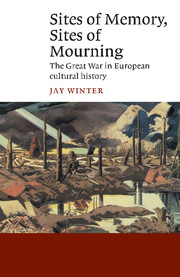Book contents
- Frontmatter
- Contents
- List of illustrations
- Acknowledgements
- List of abbreviations
- Introduction
- I Catastrophe and consolation
- II Cultural codes and languages of mourning
- 5 Mythologies of war: films, popular religion, and the business of the sacred
- 6 The apocalyptic imagination in art: from anticipation to allegory
- 7 The apocalyptic imagination in war literature
- 8 War poetry, romanticism, and the return of the sacred
- 9 Conclusion
- Notes
- Bibliography
- Index
6 - The apocalyptic imagination in art: from anticipation to allegory
- Frontmatter
- Contents
- List of illustrations
- Acknowledgements
- List of abbreviations
- Introduction
- I Catastrophe and consolation
- II Cultural codes and languages of mourning
- 5 Mythologies of war: films, popular religion, and the business of the sacred
- 6 The apocalyptic imagination in art: from anticipation to allegory
- 7 The apocalyptic imagination in war literature
- 8 War poetry, romanticism, and the return of the sacred
- 9 Conclusion
- Notes
- Bibliography
- Index
Summary
Eschatology, the science of the last things, flourished during and after the Great War. Among its most powerful and lasting forms were painting and sculpture, produced by both soldiers and civilians. Through an examination of the work of a number of artists, we can appreciate the richness and diversity of the search for older forms and images by means of which enduring visions of the Great War were fashioned.
Most of these works revived aspects of the nineteenth-century romantic tradition. Within the literature of art history, this finding breaks no new ground. Apocalyptic motifs have preoccupied artists of many different schools and periods. But by placing these twentieth-century renderings of a set of ancient themes within the wider cultural history of the war, it may be possible to show how a number of artists drew upon and amplified other currents of cultural expression in the period following the outbreak of war in 1914.
To develop this point may prove useful in another way. It may help to obliterate the outmoded distinction between elite and masses, between avant-garde and rear-guard, between highbrow and middlebrow, which still bifurcates scholarship in cultural history. The art discussed in this chapter was little known at the time of its creation; its dissemination in later years was limited. But the work of Beckmann, Dix, Rouault, Stanley Spencer was neither marginal nor esoteric; they were closer to the centre of their culture than may appear at first sight, and shared much with the peoples among whom they lived and worked.
- Type
- Chapter
- Information
- Sites of Memory, Sites of MourningThe Great War in European Cultural History, pp. 145 - 177Publisher: Cambridge University PressPrint publication year: 1998

